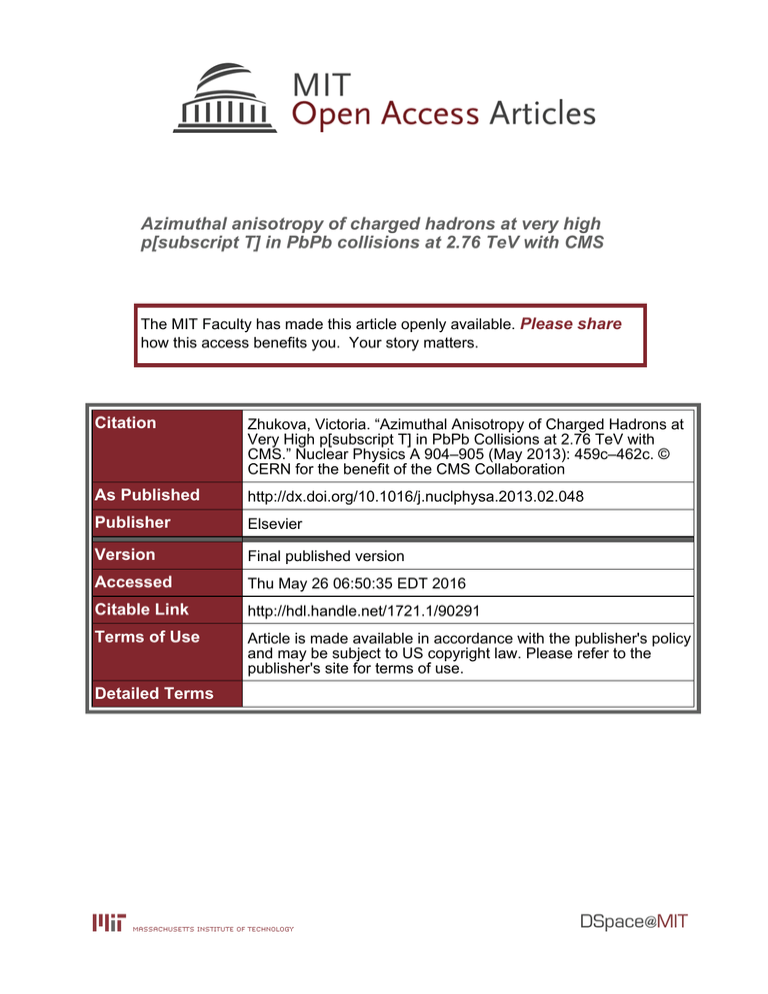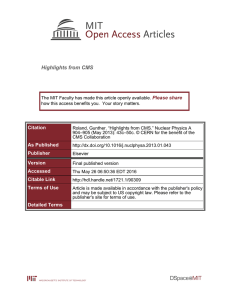Azimuthal anisotropy of charged hadrons at very high
advertisement

Azimuthal anisotropy of charged hadrons at very high
p[subscript T] in PbPb collisions at 2.76 TeV with CMS
The MIT Faculty has made this article openly available. Please share
how this access benefits you. Your story matters.
Citation
Zhukova, Victoria. “Azimuthal Anisotropy of Charged Hadrons at
Very High p[subscript T] in PbPb Collisions at 2.76 TeV with
CMS.” Nuclear Physics A 904–905 (May 2013): 459c–462c. ©
CERN for the benefit of the CMS Collaboration
As Published
http://dx.doi.org/10.1016/j.nuclphysa.2013.02.048
Publisher
Elsevier
Version
Final published version
Accessed
Thu May 26 06:50:35 EDT 2016
Citable Link
http://hdl.handle.net/1721.1/90291
Terms of Use
Article is made available in accordance with the publisher's policy
and may be subject to US copyright law. Please refer to the
publisher's site for terms of use.
Detailed Terms
Available online at www.sciencedirect.com
Nuclear Physics A 904–905 (2013) 459c–462c
www.elsevier.com/locate/nuclphysa
Azimuthal anisotropy of charged hadrons at very high pT in PbPb
collisions at 2.76 TeV with CMS
Victoria Zhukova (for the CMS Collaboration)1
Massachusetts Institute of Technology, Cambridge, MA, USA
Abstract
Measurements of the azimuthal anisotropy of charged hadrons are presented for PbPb collisions at 2.76 TeV over an extended transverse momentum range up to approximately 60 GeV/c.
The data were collected with the CMS detector at the LHC. Utilizing a novel and unique highpT single-track high-level trigger, the analysis explores the full 2011 PbPb data set corresponding
to an integrated luminosity of 150 μb−1 . Anisotropy parameters (v2 , v3 and v4 ) are extracted by
correlating charged tracks with the event plane reconstructed using the energy deposited in the
forward calorimeters. The results presented in this talk significantly improve on the statistical
precision of previous v2 measurements for pT > 12 GeV/c, and explore for the first time the harmonic components of the azimuthal dependence in the very high pT region beyond 20 GeV/c.
These new data can impose quantitative constraints on the details of in-medium parton energy
loss models, particularly the influence of the path length and the shape of the interaction region.
1. Introduction
Recent measurements of nuclear modification factors [1] and momentum imbalance of backto-back jets [2, 3] provide evidence for a more significant energy loss by partons propagating
through the dense QCD medium at LHC than at RHIC. Due to the ellipsoidal shape of the interaction region in a non-central heavy ion collision partons lose different amount of energy
depending on the direction they propagate. This leads to a non-zero v2 . Different theoretical
predictions suggest different parton energy loss scenarios, δE ∝ Lα [4, 5, 6, 7] with α = 1 for
collisional energy loss scenario and α = 2 for radiative energy loss scenario, while α = 3 is
predicted by the AdS/CFT gravity-gauge dual model. The signficance of this measurement is
that it can provide further constraints on the modeling of parton energy loss.
2. Experimental Details
√
The data set of 150 μb−1 of total integrated luminosity of PbPb collisions at sNN = 2.76
TeV was collected using the CMS detector [8]. Central feature of the CMS detector is a magnetic solenoid of 3.8 T magnetic field. The inner tracker that was used for particle reconstruction
1A
list of members of the CMS Collaboration and acknowledgements can be found at the end of this issue.
© CERN for the benefit of the CMS Collaboration.
0375-9474/ © 2013 CERN Published by Elsevier B.V. All rights reserved.
http://dx.doi.org/10.1016/j.nuclphysa.2013.02.048
460c
V. Zhukova / Nuclear Physics A 904–905 (2013) 459c–462c
in the pseudo rapidity range of |η| < 2 is located within the field volume. The set of two Forward Hadronic (HF) calorimeters with the pseudo rapidity coverage of 3 < |η| < 5 was used to
determine event planes.
Azimuthal anisotropy measurement below 12 GeV/c in pT was performed based on minimum
bias data. To extract v2 above 12 GeV/c in pT , a special single track trigger was implemented.
This triggered required a presence of at least one track above the threshold. Total of 20 million
events with at least one track with pT above 20 GeV/c were collected using this trigger.
Azimuthal anisotropy was measured using the event-plane method. The observed v2 signal
was obtained by correlating produced hadrons with the event plane. To account for the reconstruction of the event planes, the observed v2 values were scaled by the resolution correction
factor, R. Resolution correction values varied from 0.55 to 0.84 with the peak value corresponding to 20-30% bin. Further details of the method for this measurement can be found in the
documentation for the lower pT azimuthal anisotropy results in Ref. [9].
3. Results
v2{EP}
Pseudorapidity gap between the tracks and event plane they are correlated with was introduced to suppress dijet contribution to the v2 signal. This was done by correlating the tracks on
one of the pseudorapidity sides,η > 0 (η < 0), with the event plane obtained on the opposite
pseudo rapidity side, −5 < η < −3 (3 < η < 5). Fig. 1 shows a complete systematic study of v2
as a function of the pseudo rapidity gap in 6 centrality classes (as shown in different panels) for
different pT bins (as shown by different colors). Based on this study a systematic uncertainty of
±2.5% (central events) and ±10% (peripheral events) was assigned to the final v2 values.
0.3
10 - 20%
0 - 10%
20 - 30%
0.25
0.2
0.15
CMS Lint = 150 μ b-1
pT (GeV/c)
PbPb sNN = 2.76 TeV
2.4 - 3.2
CMS Preliminary
1.6 - 1.8
0.1
1.0 - 1.1
9.6 - 12.0
0.05
35.2 - 48.0
v2{EP}
0
0.3
40 - 50%
30 - 40%
50 - 60%
0.25
0.2
0.15
0.1
0.05
0
0
1
2
3
4
5
Δηgap
0
1
2
3
4
5
Δηgap 0
1
2
3
4
5
Δηgap
Figure 1: Systematic study of v2 as a function of the pseudorapidity gap size between tracks and event plane for 5 selected
pT bins shown on each panel, where each panel corresponds to a different centrality range.
461c
V. Zhukova / Nuclear Physics A 904–905 (2013) 459c–462c
0.25
0.2
v2
0.15
0-10%
CMS Lint = 150 μ b-1
10-20%
20-30%
40-50%
50-60%
PbPb sNN = 2.76 TeV
|η|<1
CMS 2011
CMS 2010, |η|<0.8
ATLAS
ALICE
0.1
0.05
0
-0 05
0.25
30-40%
0.2
v2
0.15
0.1
0.05
0
-0.05
10
20
30
40
p (GeV/c)
T
50
10
20
30
40
pT (GeV/c)
50
10
20
30
40
pT (GeV/c)
50
Figure 2: Azimuthal anisotropy, v2 , as a function of transverse momentum, pT , of charged hadrons detected by the CMS
√
detector in PbPb collisions at sNN = 2.76 TeV in 0 − 60% centrality range for |η| < 1. Error bars show statistical
uncertainties, while the gray bands represent systematic uncertainties.
Fig. 2 shows the pT dependence of v2 in 6 centrality classes at mid rapidity (|η| < 1). CMS
results of 2010 based just on minimum bias data in a slightly different pseudo rapidity range
(|η| < 0.8) are shown on the same plot. Good agreement is observed across the experiments
when comparing with ATLAS [11] and ALICE [12] results. There is a gradual decrease of v2
above pT 10 GeV/c. v2 remains finite up to 40 GeV/c. pT dependence of v2 was also studied in
the slightly forward pseudo rapidity region (1 < |η| < 2). Similar trends are observed between
the two pseudo rapidity regions. Higher harmonics results (v3 and v4 ) were also measured as
a function of pT . Within the statistical uncertainties the results are consistent with zero above
pT ≈ 20 GeV/c.
Fig. 3 shows the centrality dependence of v2 . The number of participating nucleons for each
centrality bin was calculated based on the Glauber model. Different pT bins are shown in different
panels. Each panel also compares the two pseudorapidity regions: |η| < 1 and 1 < |η| < 2. Within
the statistical uncertainties no pseudorapidity dependence is observed for all the pT bins. As the
number of participants increases azimuthal anisotropy, v2 , decreases. This trend persists up to
pT ≈ 48 GeV/c. At pT less than a few GeV/c this dependence is well understood by the interplay
between eccentricity values (geometry of the collision) and the hydrodynamic flow. This is a
direct indication that azimuthal anisotropy at high pT is also sensitive to the initial geometry.
4. Summary
In summary, the azimuthal anisotropy of charged hadrons using the event-plane method has
√
been measured in PbPb collisions at sNN = 2.76 TeV with the CMS detector. The measurements (v2 , v3 and v4 ) extend beyond pT = 20 GeV/c up to approximately 60 GeV/c. A rapid rise
up to pT ≈ 3 GeV/c is observed, followed by a rapid fall up to pT ≈ 10 GeV/c for the second
harmonic. Azimuthal anisotropy is finite up to pT ≈ 40 GeV/c for all the centralities independent
462c
V. Zhukova / Nuclear Physics A 904–905 (2013) 459c–462c
1.0 < p < 1.1 GeV/c
T
3.2 < p < 4.0 GeV/c
14 < p < 16 GeV/c
35.2 < pT < 48 GeV/c
48 < pT < 60.8 GeV/c
T
T
|η|<1
0.2
v2
1<|η|<2
0.1
0.0
CMS Lint = 150 μ b-1
PbPb sNN = 2.76 TeV
28.8 < p < 35.2 GeV/c
T
v2
0.2
0.1
0.0
100
200
Npart
300
100
200
Npart
300
100
200
Npart
300
Figure 3: Azimuthal anisotropy, v2 , as a function of the number of participating nucleons, (N part ) for |η| < 1 (red solid
√
circles) and 1 < |η| < 2 (blue open squares) in sNN = 2.76 TeV PbPb collisions with the CMS detector. Different
panels correspond to 6 selected pT bins. Gray bands represent systematic uncertainties.
of pseudorapidity. The centrality dependence of v2 suggests a connection to the initial geometry
of the collision. These high precision data will provide an important input for the parton energy
loss models.
References
[1]
[2]
[3]
[4]
[5]
[6]
[7]
[8]
[9]
[10]
[11]
[12]
S. Chatrchyan et al. [CMS Collaboration], Eur. Phys. J. C 72, 1945 (2012) [arXiv:1202.2554 [nucl-ex]].
S. Chatrchyan et al. [CMS Collaboration], Phys. Rev. C 84, 024906 (2011) [arXiv:1102.1957 [nucl-ex]].
S. Chatrchyan et al. [CMS Collaboration], Phys. Lett. B 712, 176 (2012) [arXiv:1202.5022 [nucl-ex]].
S. Wicks, W. Horowitz, M. Djordjevic and M. Gyulassy, Nucl. Phys. A 784, 426 (2007) [nucl-th/0512076].
J. Jia and R. Wei, Phys. Rev. C 82, 024902 (2010) [arXiv:1005.0645 [nucl-th]].
T. Renk, Phys. Rev. C 83, 024908 (2011) [arXiv:1010.4116 [hep-ph]].
B. Betz, M. Gyulassy and G. Torrieri, Phys. Rev. C 84, 024913 (2011) [arXiv:1102.5416 [nucl-th]].
The CMS Experiment at the CERN LHC. JINST, 3:S08004, 2008.
S. Chatrchyan et al. [CMS Collaboration], arXiv:1204.1409 [nucl-ex].
S. Chatrchyan et al. [CMS Collaboration], arXiv:1204.1850 [nucl-ex].
G. Aad et al. [ATLAS Collaboration], Phys. Lett. B 707, 330 (2012) [arXiv:1108.6018 [hep-ex]].
KAamodt et al. [ALICE Collaboration], Phys. Rev. Lett. 105, 252302 (2010) [arXiv:1011.3914 [nucl-ex]].

![Measurement of high-p[subscript T] azimuthal anisotropy](http://s2.studylib.net/store/data/012114750_1-8c17f8c182d12026a0fc21f987b5688c-300x300.png)




